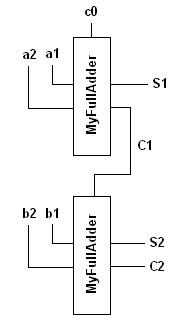
|
- A Logic Circuit Simulation Library in C++ |

|
- A Logic Circuit Simulation Library in C++ |
The aim of this example is it to be able to build a 2-bit fulladder using two 1-bit fulladder modules as shown below.

The 1-bit fulladder module should be built using the off-the-shelf logic gates in libLCS. The code is as follows.
#include <iostream> #include <lcs/or.h> #include <lcs/and.h> #include <lcs/not.h> #include <lcs/tester.h> #include <lcs/simul.h> #include <lcs/changeMonitor.h> // All classes of the libLCS are defined in the namespace lcs. using namespace lcs; using namespace std; // Define a class MyFullAdder. Our 1-bit fulladder modules will be instances // of this class. class MyFullAdder { public: // The constructor should take single line Bus<1> objects as inputs, one each for // the two data lines, carry input, sum output and the carry output. MyFullAdder(const Bus<1> &S, const Bus<1> &Cout, const Bus<1> &A, Bus<1> &B, Bus<1> &Cin); // The destructor. ~MyFullAdder(); private: // a, b, c are the two data inputs and the carry input respectively. Bus<1> a, b, c; // s is the sum output, and cout is the carry output. Bus<1> s, cout; // A pointer member for each of the gates which constitute our FullAdder. // The number and type of the gates is same as in the 1st basic example. Not<> *n1, *n2, *n3; And<3> *sa1, *sa2, *sa3, *sa4; And<3> *ca1, *ca2, *ca3, *ca4; Or<4> *so, *co; }; MyFullAdder::MyFullAdder(const Bus<1> &S, const Bus<1> &Cout, const Bus<1> &A, Bus<1> &B, Bus<1> &Cin) : a(A), b(B), c(Cin), s(S), cout(Cout) { Bus<> a_, b_, c_, s1, s2, s3, s4, c1, c2, c3, c4; // Each of the gates should be initialised with proper bus // connections. The connections are same as in the 1st basic // example. // Initialising the NOT gates. n1 = new Not<>(a_, a); n2 = new Not<>(b_, b); n3 = new Not<>(c_, c); // Initialising the AND gates for the // minterms corresponding to the sum output. sa1 = new And<3>(s1, (a_,b_,c)); sa3 = new And<3>(s3, (a,b_,c_)); sa2 = new And<3>(s2, (a_,b,c_)); sa4 = new And<3>(s4, (a,b,c)); // Initialising the AND gates for the // minterms corresponding to the carry output. ca1 = new And<3>(c1, (a_,b,c)); ca2 = new And<3>(c2, (a,b_,c)); ca3 = new And<3>(c3, (a,b,c_)); ca4 = new And<3>(c4, (a,b,c)); // Initialising the OR gates which // generate the final outputs. so = new Or<4>(s, (s1,s2,s3,s4)), co = new Or<4>(cout, (c1,c2,c3,c4)); } MyFullAdder::~MyFullAdder() { // The destructor should delete each of the gates // which were initialised during construction. delete n1; delete n2; delete n3; delete sa1; delete sa2; delete sa3; delete sa4; delete ca1; delete ca2; delete ca3; delete ca4; delete so; delete co; } int main(void) { // Declaring the busses involved in out circuit. // Note that the bus c0 (the carry input to the first full-adder) // has been initialised with a value of 0 (or lcs::LOW) on its line. Bus<> a1, b1, a2, b2, c0(0), S1, C1, S2, C2; // Initialising the 1-bit full adder modules. MyFullAdder fa1(S1, C1, a1, a2, c0), fa2(S2, C2, b1, b2, C1); // Initialising monitor objects which monitor the inputs and the // 3 sum bits. ChangeMonitor<4> inputMonitor((a1,b1,a2,b2), "Input", DUMP_ON); ChangeMonitor<3> outputMonitor((S1,S2,C2), "Sum", DUMP_ON); // Initialising a tester object which feeds in different inputs // into our circuit. Tester<4> tester((a1,b1,a2,b2)); Simulation::setStopTime(2000); // Set the time upto which the simulation should run. Simulation::start(); // Start the simulation. return 0; }
When the above code is compiled and run, the following output is obtained.
At time: 0, Input: 0000 At time: 0, Sum: 000 At time: 200, Input: 0001 At time: 200, Sum: 001 At time: 300, Input: 0010 At time: 300, Sum: 010 At time: 400, Input: 0011 At time: 400, Sum: 011 At time: 500, Input: 0100 At time: 500, Sum: 001 At time: 600, Input: 0101 At time: 600, Sum: 010 At time: 700, Input: 0110 At time: 700, Sum: 011 At time: 800, Input: 0111 At time: 800, Sum: 100 At time: 900, Input: 1000 At time: 900, Sum: 010 At time: 1000, Input: 1001 At time: 1000, Sum: 011 At time: 1100, Input: 1010 At time: 1100, Sum: 100 At time: 1200, Input: 1011 At time: 1200, Sum: 101 At time: 1300, Input: 1100 At time: 1300, Sum: 011 At time: 1400, Input: 1101 At time: 1400, Sum: 100 At time: 1500, Input: 1110 At time: 1500, Sum: 101 At time: 1600, Input: 1111 At time: 1600, Sum: 110
Below is the screenshot of the gtkwave plot of the generated VCD file.

